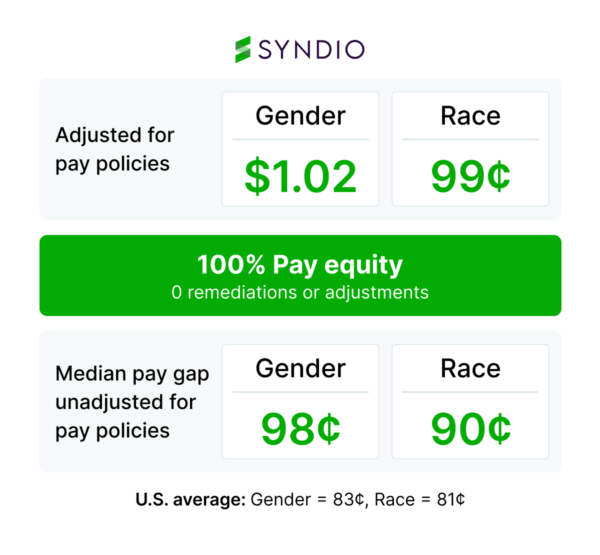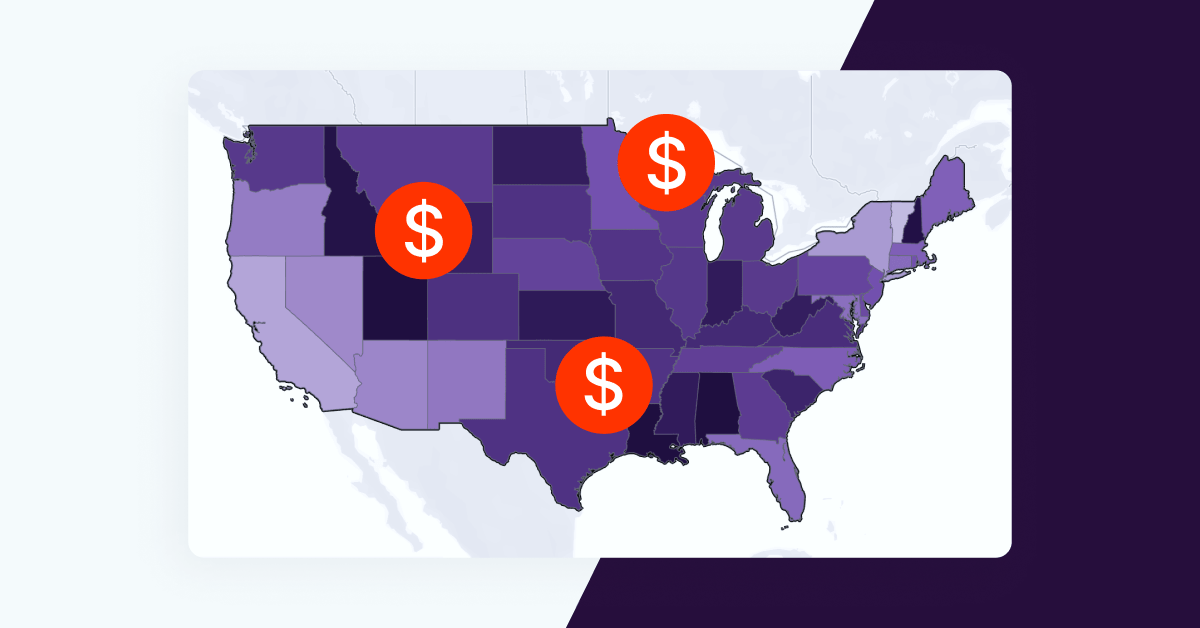Syndio has been driving home an urgent message this year: we’re in a new era of transparency and companies that proactively embrace transparency around pay and promotions will harness a competitive advantage — building trust with employees, attracting and retaining top talent, and strengthening their culture and employer brand.
For us, it’s more than just talk. We aim to walk the pay transparency walk and hold ourselves to the same level of accountability that we encourage for our customers. That’s why we’re once again publicly sharing the results of our internal pay equity analysis. We discussed our results with Syndio employees during a recent All-Hands meeting, and we’re also sharing it publicly on our blog to model what pay transparency looks like in practice.
Overall, our analysis using the Syndio Workplace Equity Platform indicates that we’re doing well. This includes sustaining 100% pay equity since our last biannual analysis. And like the majority of customers we serve, there are opportunities for us to address pay gaps across both race and gender. As we know at Syndio, achieving workplace equity is an ongoing journey that requires commitment and perseverance.
“A commitment to pay transparency means being candid with employees regardless of outcomes or results. “
– Maria Colacurcio, Syndio CEO
Pay equity at Syndio
The numbers: We continue to sustain 100% pay equity and did not need to make adjustments or remediation. Our “adjusted pay gap” is $1.02 (previously $1.05) for gender and $0.99 (previously $0.97) for race.
What’s the difference between pay equity and pay gaps? Learn here >
The context: We see some fluctuations on a percentage basis since our last analysis, but this is not surprising given our relatively small size. In other words, small shifts in our org structure can shift our numbers in notable ways. We attribute some of the movements to shifts in our overall employee population, across levels.
Pay gaps at Syndio
The numbers: Our median pay gap (aka, unadjusted pay gap) results also shifted since our last analysis. Our median pay gap for gender is 98 cents (improved from 90 cents last year) and 90 cents for race (widened from 94 cents). For context, as reported by the Bureau of Labor Statistics for the first quarter in 2024, the average was 83 cents for women and 81 cents for URGs.
The context: While we’re pleased to see positive improvement with gender, we’re paying close attention to the shifts relative to race. As a reminder, pay gap numbers can fluctuate due to a confluence of moving parts, such as: incoming talent pipeline, employee development, and business needs for roles and promotions.
Looking specifically at the median pay gap for gender, we saw a reduction. At a macro-level, we had lower overall headcount in FY24 and hired fewer people than the prior year. The roles filled were typically higher earning positions (e.g., technical skills and senior/manager job band), and greater than 60% of those jobs were awarded to women, nonbinary, or transgender employees. While we’ve made progress, the gender gap that remains is primarily based on the current representation of men in technical roles. We will continue to address this by prioritizing a pipeline diversity metric for gender in technical roles. This is in addition to our company-wide, underrepresented group (URG) pipeline requirement.
When we turn to look at our median gap for race, we find that it widened since our last analysis. The existing gap is primarily driven by representation across higher paid job families and at more senior levels. As an example, the majority of our technical roles filled within the last year were white (29% filled by URGs), and this was somewhat similar for the senior and manager band (17% URG). While we ultimately select the most qualified talent when hiring (regardless of characteristics such as race), we continue to drive recruiting efforts that resulted in 51% URG representation in our qualified talent pool for technical roles. On the positive side, we increased our representation of URGs in technical skills at the mid-level (44%), where before we were heavily concentrated at the junior job band. Positive progress here supports our emphasis on driving individual professional development. We also looked at exit and promotion data by race and found that it mimics our representation data, internally. This gives us confidence that race is not disproportionately impacting our exits or promotions.
What’s next for Syndio
Achieving workplace equity is a constant process. It challenges us to continually assess whether we’re doing the right things, not just highlighting numbers that look good. Experts across the team agree that an organization can have perfect 1-to-1 pay equity, but still have issues under the surface. Syndio — like nearly every company — has opportunities, which our platform helps us to continually analyze, understand, and improve.
Here’s what we’re committed to doing to address our top opportunities:
- We will continue to utilize inclusive hiring practices, including posting ranges on jobs, hosting structured interviews, and building diverse hiring pools for every role.
- We will continue to track and assess our hiring, promotion, and exit data to quickly identify and address any trends that impact our workplace equity initiatives.
- Leadership will continue to work with the People Team to maintain our practice of regularly conducting these internal pay equity analyses using PayEQ® and Syndio’s Workplace Equity Platform to monitor and understand our pay gaps. Going forward, we will also utilize OppEQ® in the platform to conduct performance rating analyses.
Pay transparency comms: Our best practices
As we tell our clients, a commitment to pay transparency means being candid with employees regardless of outcomes or results. We are steadfast in our commitment to continue sharing our analysis with our employees and publicly on a regular basis as we build the home of workplace equity.
Syndio’s team includes comms experts, and our Communications Package can help you own your narrative as an employer of choice. Below are some of the key best practices we follow that we believe make for successful pay transparency communications:
- Make sure your analysis and methodology is on solid footing — trusted pay equity software can help.
- Cover both pay equity AND pay gap numbers to tell the full story of workplace equity in your organization. (Remember, a company can have 100% pay equity but still have an unadjusted pay gap which is rooted in inequitable opportunities for advancement).
- Be candid regardless of outcomes or results. Sharing where you are honestly, not just the numbers that “look good,” is what builds trust. Looking like you’re “hiding” something erodes it.
- Don’t just dump numbers — provide a narrative. What story does the data tell about your pay and promotion policies, practices, and outcomes? What are some likely contributing factors when you dig into the data? What are some explanations for fluctuations (e.g. sample size)? An explanation is not a justification, but it helps give context for why some numbers look the way they do and pinpoint areas to target.
- Use data visualizations to make your data more accessible and easier to understand.
- Share an action plan with concrete steps to address opportunities for improvement.
- Share your commitment to continued transparency going forward.
We’re here to help you with pay transparency from brand communications for Equal Pay Day to discussing your Arjuna Racial & Gender Pay Scorecard results to prepping for the EU Pay Transparency Directive.
Our latest resources include a guide on How to Win in the Transparency Era and a 12-question assessment that shows how prepared your organization is for pay and promotions transparency. Wherever you are in your journey, Syndio is here to help.
The information provided herein does not, and is not intended to, constitute legal advice. All information, content, and materials are provided for general informational purposes only. The links to third-party or government websites are offered for the convenience of the reader; Syndio is not responsible for the contents on linked pages.



